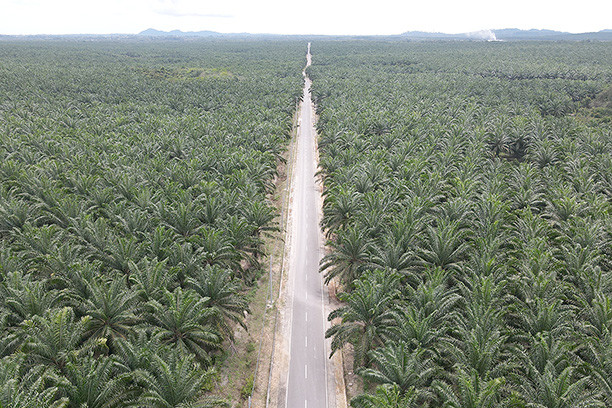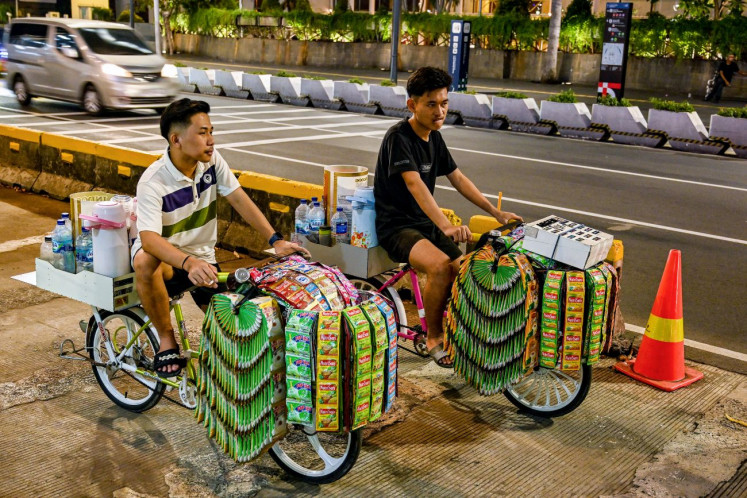Popular Reads
Top Results
Can't find what you're looking for?
View all search resultsPopular Reads
Top Results
Can't find what you're looking for?
View all search resultsDo oil palm plantations cause water scarcity?
Oil palm uses more rainwater than groundwater during growth
Change text size
Gift Premium Articles
to Anyone
W
ater scarcity is one of the major issues related to oil palm plantations. Oil palm has been branded as a “water-hungry” plant that drains the ground of water where it grows and allegedly threatens the sustainability of water resources in Indonesia.
Is it true? Is there a scientific approach to prove this accusation? How can one calculate the water consumption of crops, like oil palm, to see whether they negatively impact the environment or not?
The water footprint, also known as “virtual water content” method, can be used to illustrate the water use of crops. It can be applied to analyze the environmental sustainability of crops. The water footprint, a concept introduced by Hoekstra (2003) and later refined by Hoekstra and Chapagain (2008), presents a framework to analyze the relationship between human consumption and the allocation of fresh water in the world.
The water footprint classifies water use into three categories: green, blue and grey, specific to a location and period. Since the availability of water changes throughout the year and across years, demand also varies from time to time. Therefore, the calculation is based on the actual climate and production data in a particular area and time.
“Green” water refers to the use of rainwater during crop growth. “Blue” water is defined as surface water and groundwater used for irrigation during crop growth. Meanwhile, the “grey” component is indicative of the amount of clean water for the dilution of wastewater that contains chemical substances, such as fertilizer and pesticide, to meet the standard of surface water.
The water footprint of a product is not the same as the actual water content of a product. According to Hoekstra and Chapagain, the water footprint of a product (commodity, good or service) is defined as the volume of freshwater used to produce a product at the place where it is actually produced.
Therefore, we cannot say that the global average water footprint of one product is larger than the global average water footprint of another product, since the comparison may turn out quite differently for specific regions and periods. Besides, crop productivity (which is the main parameter for the water footprint) varies in different regions depending on the climate, soil properties and so on.
Recent studies have been conducted regarding the water footprint of oil palm plantations in Indonesia. In 2017, Kospa et al. revealed that the total water footprint of oil palm from state-owned plantation company (PTP) Mitra Ogan Baturaja in South Sumatra is 980.9 cubic meters/ton, of which 83.6 percent is green water, 2 percent blue water and 16.67 percent grey water. The data used was from 2014. Another study was conducted by Santosa et al. (2018) at PTPN IV located in North Sumatra. Santosa et al. used field data collected from February to June 2016; the oil palm plantation consumed 510.69 m3/ton of water, with green, blue and grey water making up 94.78 percent, 0.71 percent, and 4.52 percent, respectively, of the total Safitri et al. (2018) calculated the water footprint of oil palm plantations in Pundu Village, Central Kalimantan, from 2011 to 2015. The study revealed that 1002.1 m3/ton water was used to cultivate the oil palm, with 87.4 percent being green water, 3.5 percent blue water and 8.9 percent grey water.
The studies conducted in Indonesia point to a high percentage of green water (83.6 to 94.78 percent) and a low percentage of blue water, which means the oil palm used more rainwater than groundwater as the primary source during growth. Chapagain and Hoekstra (2010) calculated the water footprint of rice, and it revealed a high share of blue water, as blue water accounted for around 44 percent of water consumed. That is far higher than oil palm, that only needs 2 percent to 3.5 percent groundwater to grow. Moreover, a low percentage of grey water, around 4 percent to 16 percent, also revealed that the use of fertilizer for oil palm cultivation is lower than for other crops, such as tobacco, which has a grey water percentage of 23 percent. The total water footprint for oil palm is even lower when compared to other oil-producing crops, such as coconut (2,687 m3/ton), sunflower seeds (3,366 m3/ton), olives (3,015 m3/ton) or castor oil seeds (9,896 m3/ton) (Mekonnen and Hoekstra, 2011).
However, the water footprint alone is not enough to assess the actual impact of oil palm plantations on the sustainability of water resources in Indonesia, given that there will be differences in the impact between areas with abundant water and those with scarcity. As emphasized in the UNDP’s Human Development Report 2006, water consumption is not the only factor causing water scarcity.
Geographical, climate, environmental, economic and political factors should be accounted for and observed thoroughly to see the big picture of the oil plantation impact on Indonesia's water resources. This is expected to substantially increase the efficiency of water usage across all sectors and ensure sustainable withdrawals and supply of freshwater to address water scarcity and substantially reduce the number of people suffering from water scarcity, as stated in the sustainable development goals (SDG) by the United Nations.
Nevertheless, according to Gheewala et al. (2014), by calculating the water footprint of oil palm, the government can at least prepare a proper and appropriate plan for sustainable water resource management to prevent water stress from the vast expansion of oil palm plantations in the future. One of the factors that affect the water footprint significantly is crop yield. By improving crop productivity, the water footprint will be reduced.
Therefore, conducting good and responsible agricultural practices is crucial. Moreover, improving the irrigation system in areas that potentially have high water stress is also pertinent. Identifying suitable areas in terms of water availability and water stress before plantation requires careful consideration.
More importantly, the government should increase efforts to control deforestation, which has a greater negative impact than the plantation itself.
***
The writer is an analyst at the Research Center for Biomaterial at the Indonesian Institute of Sciences. These views are personal.










